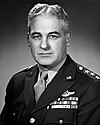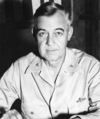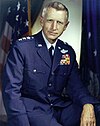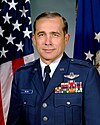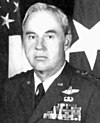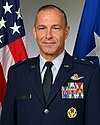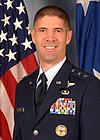Thirteenth Expeditionary Air Force
This article includes a list of general references, but it lacks sufficient corresponding inline citations. (June 2023) |
| Thirteenth Expeditionary Air Force | |
|---|---|
 Shield of the Thirteenth Air Force | |
| Active | 29 September 2012 – present (as Thirteenth Expeditionary Air Force) 16 January 2007 – 28 September 2012 (as Thirteenth Air Force (Air Forces Pacific)) 1 February 1953 – 16 January 2007 8 February 1952 – 1 February 1953 14 December 1942 – 8 February 1952 (as Thirteenth Air Force) (82 years, 1 month)[1] |
| Country | |
| Branch | |
| Type | Numbered Air Force |
| Role | Provide combat-ready air forces for U.S. Pacific Command[2] |
| Part of | |
| Garrison/HQ | Hickam Air Force Base, Joint Base Pearl Harbor–Hickam, Hawaii |
| Nickname(s) | Jungle Air Force |
| Engagements | World War II – Asiatic-Pacific Theater [1] Second Taiwan Strait Crisis |
| Decorations | Air Force Outstanding Unit Award Philippine Presidential Unit Citation Republic of Vietnam Gallantry Cross with Palm[1] |
| Commanders | |
| Current commander | Maj Gen Brandon D. Parker |
| Notable commanders | Nathan F. Twining Hubert R. Harmon Benjamin O. Davis Jr. |
The Thirteenth Expeditionary Air Force (13 EAF) is a provisional numbered air force of the United States Air Force Pacific Air Forces (PACAF). It is headquartered at Hickam Air Force Base, Joint Base Pearl Harbor–Hickam on the island of Oahu, Hawaii. It has never been stationed in the continental United States.
The command plans, commands and controls, delivers, and assesses air, space, and information operations in the Asia-Pacific region—excluding the Korea theater of operations—across the security spectrum from peacetime engagement to major combat operations.
Established on 14 December 1942 at Plaine Des Gaiacs Airfield, on New Caledonia, 13 AF was a United States Army Air Forces combat air force deployed to the Pacific Theater of World War II. It engaged in operations primarily in the South Pacific, attacking enemy forces in the Solomon Islands, Gilbert and Marshall Islands campaigns; Mariana and Palau Islands campaigns and the Philippines campaign (1944–45).
During the Cold War, 13 AF remained in the Philippines, providing air defense of the nation and becoming one of the Numbered Air Forces of Pacific Air Forces (PACAF). During the Korean War, its units provided staging areas for people and equipment destined for the war zone. As the Vietnam War escalated during the late 1960s and early 1970s, 13th AF provided command and control for USAF units stationed in Thailand, its units conducting combat missions throughout Indochina until August 1973. 13 AF units last engaged in combat during the SS Mayaguez Incident in May 1975.
Returning to the Philippines after the Vietnam War ended in 1975, the command remained there until the 1991 evacuation of Clark Air Base after the Mount Pinatubo eruption and the United States withdrawal of military forces afterward.
It was inactivated on 28 September 2012 and its functions merged with PACAF. The next day, the organization was converted to provisional status and reactivated as the Thirteenth Expeditionary Air Force.
Overview
[edit]The command is charged with planning, executing, and assessing operations in support of the U.S. Pacific Command commander's objectives. On behalf of the Pacific Air Forces commander, the 13th AF commander is positioned to command Air Force forces, combined or joint force air components, or a joint task force. Thirteenth AF also commands the only Air Force-led standing joint task force, Joint Task Force Support Forces Antarctica, a collaborative Department of Defense and National Science Foundation effort supporting the U.S. Antarctic Program through Operation Deep Freeze.
Headquarters, 13 AF is made up of an A-staff (the Air Force Forces staff), personal staff, 613th Air and Space Operations Center (AOC), known as the Maj Richard Bong AOC, and the 613th Support Group. The 613th AOC is one of the U.S. Air Force's five full-capability AN/USQ-163 FALCONER weapon systems with the ability to plan, task, execute, monitor, and assess full-spectrum air, space, and information operations for the COMAFFOR and/or C/JFACC. The AOC serves as the nerve center of air operations during any campaign.
In June 1991, Mount Pinatubo buried Clark Air Base, Philippines, in volcanic ash, leading to the evacuation of military personnel and their families in Operation Fiery Vigil, eventually forcing the base to close 26 November 1991. Thirteenth AF relocated and officially established its headquarters at Andersen AFB, Guam, on 2 December 1991.
The command was moved from Guam to Hickam AFB in May 2005. In the early 2000s, 13 AF activated the 13th Air Expeditionary Group for a number of exercises, (February 2004-1 April 2004 for Exercise Balikatan 04; February–March 2004 for Exercise Cope Tiger 04; January–February 2005 for Exercise Cope Tiger 05.
History
[edit]Thirteenth Air Force has never been stationed in the continental United States; it is also one of the oldest, continuously active, numbered air forces. It engaged in combat in the Pacific Theater during World War II. Since World War II, it has provided air defense in the Far East, primarily the Philippines, until the 1991 eruption of Mt. Pinatubo forced the closure of Clark AB. Numerous Thirteenth Air Force organizations participated in Southeast Asia combat operations in the 1960s and 1970s.
Lineage
[edit]- Established as Thirteenth Air Force on 14 December 1942
- Activated on 13 January 1943
- Inactivated on 8 February 1952
- Activated on 1 February 1953
- Redesignated as Thirteenth Air Force (Air Forces Pacific) on 16 January 2007
- Inactivated on 28 September 2012
- Redesignated as Thirteenth Expeditionary Air Force, and converted to provisional status, on 29 September 2012
- Activated on 29 September 2012[3]
Assignments
[edit]- United States Army Forces in the Far East, 14 December 1942
- Far East Air Forces, 15 June 1944 – 8 February 1952, 1 February 1953 – 17 May 1955
- Pacific Air Force (later, Pacific Air Force/FEAF [Rear]), 17 May 1955 – 1 July 1957
- Pacific Air Forces, 1 July 1957 – 28 September 2012
- Pacific Air Forces, to activate or inactivate at any time, 29 September 2012 – present[3]
Stations
[edit]World War II
[edit]Commands
[edit]During World War II, 13th AF consisted of two major commands, XIII Fighter Command and XIII Bomber Command.
XIII Fighter Command
[edit]Activated on 13 January 1943. Served in combat with Thirteenth AF until the end of the war. Inactivated in the Philippines on 15 March 1946. Disbanded on 8 October 1948.
Groups
- 18th Fighter Group (1943–47) (P-40F, P-39, P-38, P-61, P-70)
(Transferred from Fifth Air Force, Hickam Field, Hawaii in March 1943). - 347th Fighter Group (1942–45) (P-39, P-38, P-40, P-400)
(Established on New Caledonia on 3 October 1942) - 4th Reconnaissance Group (1943–45) (F-4 (P-38))
- 403d Troop Carrier Group (1943–46) (C-46, C-47)
- Unattached Units:
- Det B 6th Night Fighter Squadron (February – September 1943) (P-70, P-38)
Reassigned to 7th Air Force, 1943. - 419th Night Fighter Squadron (April – November 1943) (P-38, P-61)
Activated April 1943 with P-38s, Reassigned to 18th Fighter Group, November 1943. Reequipped with P-61s May 1944. Served in New Guinea, Philippines. Inactivated February 1947. - 550th Night Fighter Squadron (1944–46) (P-61)
Activated June 1944. Received P-61s January 1945. Served in New Guinea, Philippines. Inactivated January 1946. - 7th Radio Squadron, Mobile (J)
- Det B 6th Night Fighter Squadron (February – September 1943) (P-70, P-38)
XIII Bomber Command
[edit]Activated on 13 January 1943. Served in combat with Thirteenth AF until the end of the war. Inactivated in the Philippines on 15 March 1946. Disbanded on 8 October 1948.
Groups
- 5th Bombardment Group (1943–46) (B-17, B-24)
(Deployed to Espiritu Santo in November 1942, reassigned from Seventh Air Force in January 1943). - 11th Bombardment Group (1943) (B-17, B-24)
(Deployed to New Hebrides in July 1942, reassigned from Seventh Air Force in January 1943. Reassigned back to Seventh Air Force, May 1943 and transferred to Hawaii) - 42d Bombardment Group (1943–45) (B-25, B-26)
(Reassigned from Second Air Force antisubmarine patrol duty, March 1943) - 307th Bombardment Group (1943–45) (B-17, B-24)
(Reassigned from Seventh Air Force, February 1943) - 868th Bombardment Squadron (Unattached) (1944–45) (B-24)
Formerly 349th Bomb Squadron, 5th Bomb Group. The planes flown by the 868th were often called SB-24s and sometimes LABs (Low Altitude Bomber). They were equipped with SRC-717-B search and navigation radar. Formed into 868th Bomb Squadron in January 1944 and operated independently within the 13th AF.
Operational history
[edit]
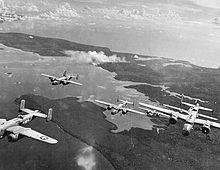
Thirteenth Air Force began operations in November 1942 as an organization composed of many widely separated Seventh Air Force and independent units scattered in the South Central Pacific during the Solomon Islands campaign.
Initially charged with taking a defensive stand against advancing enemy forces, Thirteenth Air Force later took the offensive flying a variety of aircraft, including the B-17 Flying Fortress, B-24 Liberator, B-25 Mitchell, B-26 Marauder, P-38 Lightning, P-39 Airacobra, P-40 Warhawk, P-61 Black Widow, C-46 Commando, C-47 Skytrain, and L-5 Sentinel.
It was Thirteenth Air Force P-38Gs of the 339th Fighter Squadron of the 347th Fighter Group which, on 18 April 1943, flew the mission which resulted in the death of Japanese Admiral Isoroku Yamamoto.
From 1942 to 1945, Thirteenth Air Force staged out of tropical jungles on more than 40 remote islands including the Gilbert and Marshall Islands campaign; Mariana and Palau Islands campaign and the Philippines campaign (1944–45), thus earning the nickname, "The Jungle Air Force." The command's units participated in a total of five different operation areas and 13 campaigns.
Thirteenth Air Force along with Fifth Air Force in Australia and Seventh Air Force in Hawaii were assigned to the newly created Far East Air Forces (FEAF) on 3 August 1944. FEAF was subordinate to the U.S. Army Forces Far East and served as the headquarters of Allied Air Forces Southwest Pacific Area. By 1945, three numbered air forces—5th, 7th and 13th—were supporting operations in the Pacific. FEAF was the functional equivalent in the Pacific of the United States Strategic Air Forces (USSTAF) in the European Theater of Operations.
After hostilities ended in 1945, Thirteenth Air Force established its headquarters at Clark Field, Philippines, in January 1946. In May of that year, it moved to Fort William McKinley, Luzon. By August 1947, 13AF returned to Clark Field. In December 1948, the unit moved to Kadena, Okinawa, where it remained for only a few months before returning to Clark in May 1949.
Korean War
[edit]On 25 June 1950, 13AF consisted of the following units:[4][5][6]
- 18th Fighter-Bomber Wing/Group (F-80)
- 21st Troop Carrier Squadron (C-54)
- 6204th Photo Mapping Flight (RB-17))
The 6204th Photo Mapping Flight, located at Clark AB, Philippines, deployed the Flight's two RB-17 aircraft complete with combat crews and maintenance personnel to Johnson AB, Japan in mid-June 1950. The FEAF deployment order specified that the two RB-17 aircraft be equipped with normal armament insofar as practicable, not to interfere with the photographic capability of the aircraft. This posed a problem for the Flight, since the RB-17s had been flying peacetime missions and were not equipped for combat. However, the 6204th found the necessary gunners and equipment, made the modifications to the aircraft, and by late August 1950 the detachment began flying photo-mapping missions over Korea. By the end of November 1950, it had photographed the entire North Korean area at least once and re-photographed some areas as far north as weather conditions permitted. By early December the detachment returned to Clark AB and resumed the flight's mapping program in the Philippine area.
During the Korean War, 13AF units provided staging areas for people and equipment destined for the war zone. During the decade of peace that followed the war, the command concentrated on training and surveillance activities to maintain a high state of readiness for contingencies.
Vietnam War
[edit]From the time of signing of U.S./Taiwan defense arrangements, the 327th Air Division of 13th Air Force maintained units in Taiwan, up until 1979. 327th Air Division reported in this capacity to United States Taiwan Defense Command.
As the Vietnam War escalated during the late 1960s and early 1970s, 13AF again served as a staging base and logistics manager for units fighting in Southeast Asia. As more American aircraft and people were poured into the war effort, combat units and facilities under 13AF in Thailand increased. At its peak, 13AF was composed of seven combat wings, nine major bases, 11 smaller installations and more than 31,000 military members.
With the buildup and execution of Operations Desert Shield and Storm, 13AF provided aircraft and support staff vital to the Gulf war coalition victory in Southwest Asia.
Post Cold War
[edit]In June 1991, Mount Pinatubo buried Clark in volcanic ash, forcing the base to close on 26 November and leading to the evacuation of assigned military members and their families in Operation Fiery Vigil. The Thirteenth Air Force relocated and officially established its headquarters at Andersen Air Force Base on 2 December 1991.
In 2005, the Jungle Air Force stood down as a traditional Numbered Air Force and moved to Hickam Air Force Base to assume the role of the new Kenney Warfighting Headquarters for PACAF, which was activated in provisional status in June 2005.
On 6 October 2006, after a one-year transformation of command and control of air, space and information operations in the Pacific, Thirteenth Air Force officially began operations as a component numbered air force headquarters and welcomed a new commander. Former Pacific Air Forces Deputy Commander, Lt. Gen. Loyd S. "Chip" Utterback, assumed command of the unit 6 October, replacing Maj. Gen. Edward A. Rice Jr., who had commanded Thirteenth Air Force from Andersen Air Force Base, Guam, and Hickam since January 2005. Previously designated as a management headquarters, Thirteenth Air Force became one of 10 organizations designed to enhance the operational level support, planning, command, control and execution of air, space and information operations capabilities across the full range of military operations throughout the U.S. Pacific Command's area of responsibility (minus the Korea theater of operations). On 28 September 2012, 13 AF was inactivated and its functions merged into PACAF.[7]
Prior to its inactivation, units assigned to 13 AF included:
- 15th Wing, Hickam AFB Hawaii, providing airlift with C-17s, one specially configured C-40 and one C-37. It also includes a squadron of Lockheed F-22s.
- 36th Wing, Andersen AFB, Guam, maintaining a strategically located base;
- Detachment 1, 13 AF was activated at Yokota AB, Japan. Det 1 was responsible for planning, coordinating, and executing air operations around Japan in coordination with the Japan Air Self Defense Force;
- 613th Support Group
The 13th Air Expeditionary Group, and formerly the 500th Air Expeditionary Group, was activated seasonally to support Operation Deep Freeze in the Antarctic.
On 29 September 2012, the Thirteenth Air Force was converted to provisional status and reactivated as the Thirteenth Expeditionary Air Force.[3] The organization is commanded by the Director of Air and Cyberspace Operations of Pacific Air Forces.[8]
List of commanders
[edit]Thirteenth Air Force (1943–2012)
[edit]| No. | Commander[3] | Term | |||
|---|---|---|---|---|---|
| Portrait | Name | Took office | Left office | Term length | |
| 1 | Major General Nathan F. Twining | 13 January 1943 | 27 July 1943 | 195 days | |
| 2 | Brigadier General Ray L. Owens | 27 July 1943 | 7 January 1944 | 164 days | |
| 3 | Major General Hubert R. Harmon | 7 January 1944 | 6 June 1944 | 151 days | |
| - | Brigadier General George L. Usher Acting | 6 June 1944 | 15 June 1944 | 9 days | |
| 4 | Major General St. Clair Streett | 15 June 1944 | 19 February 1945 | 249 days | |
| 5 | Major General Paul B. Wurtsmith | 19 February 1945 | 4 July 1946 | 1 year, 135 days | |
| 6 | Major General Eugene L. Eubank | 4 July 1946 | November 1948 | c. 2 years, 4 months | |
| 7 | Brigadier General Jarred V. Crabb | November 1948 | 1 December 1948 | c. 1 month | |
| 8 | Major General Charles T. Myers | 1 December 1948 | c. 30 May 1949 | 180 days | |
| 9 | Major General Howard M. Turner | c. 30 May 1949 | 16 October 1951 | 2 years, 139 days | |
| 10 | Major General Ernest Moore | 16 October 1951 | 10 October 1952 | 360 days | |
| 11 | Major General John W. Sessums, Jr. | 10 October 1952 | 27 August 1954 | 1 year, 321 days | |
| 12 | Brigadier General William L. Lee | 27 August 1954 | 15 September 1956 | 2 years, 19 days | |
| 13 | Major General John B. Ackerman | 15 September 1956 | February 1958 | 1 year, 166 days | |
| 14 | Major General Thomas S. Moorman | 14 April 1958 | 19 June 1961 | 3 years, 66 days | |
| 15 | Major General Theodore R. Milton | 19 June 1961 | 24 July 1963 | 2 years, 35 days | |
| 16 | Major General Sam Maddux Jr. | 24 July 1963 | 1 July 1965 | 1 year, 342 days | |
| 17 | Lieutenant General James W. Wilson | 1 July 1965 | 1 August 1967 | 2 years, 31 days | |
| 18 | Lieutenant General Benjamin O. Davis Jr. | 1 August 1967 | 1 August 1968 | 1 year, 0 days | |
| 19 | Lieutenant General Francis C. Gideon | 1 August 1968 | 1 February 1970 | 1 year, 184 days | |
| 20 | Lieutenant General Marvin L. McNickle | 1 February 1970 | 1 September 1972 | 2 years, 213 days | |
| 21 | Lieutenant General William G. Moore | 1 September 1972 | 1 October 1973 | 1 year, 30 days | |
| 22 | Major General Leroy J. Manor | 1 October 1973 | 8 October 1976 | 3 years, 7 days | |
| 23 | Major General Freddie L. Poston | 8 October 1976 | 9 April 1979 | 2 years, 183 days | |
| 24 | Major General James R. Hildreth | 9 April 1979 | 22 June 1981 | 2 years, 74 days | |
| 25 | Major General Kenneth D. Burns | 22 June 1981 | 6 July 1984 | 3 years, 14 days | |
| 26 | Major General Michael A. Nelson | 6 July 1984 | 17 June 1985 | 346 days | |
| 27 | Major General Gordon E. Williams | 17 June 1985 | 27 March 1986 | 283 days | |
| 28 | Brigadier General Charles F. Luigs | 27 March 1986 | 31 July 1986 | 126 days | |
| 29 | Major General Michael P. C. Carns | 31 July 1986 | 19 June 1987 | 323 days | |
| 30 | Major General Donald Snyder | 19 June 1987 | January 1990 | 2 years, 196 days | |
| 31 | Major General William A. Studer | January 1990 | 2 December 1991 | 1 year, 335 days | |
| 32 | Major General H. Hale Burr | 2 December 1991 | 21 July 1994 | 2 years, 231 days | |
| 33 | Major General Richard T. Swope | 21 July 1994 | 22 April 1996 | 1 year, 276 days | |
| 34 | Major General John R. Dallager | 22 April 1996 | 20 August 1998 | 2 years, 120 days | |
| 35 | Major General Thomas C. Waskow | 20 August 1998 | May 1999 | 254 days | |
| 36 | Major General Daniel M. Dick | May 1999 | 14 November 2000 | 1 year, 197 days | |
| 37 | Major General Theodore W. Lay II | 14 November 2000 | 21 September 2002 | 1 year, 311 days | |
| 38 | Major General Dennis R. Larsen | 21 September 2002 | 24 January 2005 | 2 years, 125 days | |
| 39 | Major General Edward A. Rice Jr. | 24 January 2005 | 6 October 2006 | 1 year, 255 days | |
| 40 | Lieutenant General Loyd S. Utterback | 6 October 2006 | 2 September 2009 | 2 years, 331 days | |
| 41 | Lieutenant General Herbert J. Carlisle | 2 September 2009 | December 2010 | 1 year, 90 days | |
| 42 | Lieutenant General Stanley T. Kresge | December 2010 | 28 September 2012 | 1 year, 302 days | |
Thirteenth Expeditionary Air Force (2012–present)
[edit]| No. | Commander[3] | Term | |||
|---|---|---|---|---|---|
| Portrait | Name | Took office | Left office | Term length | |
| 43 | Major General Russell J. Handy | 29 September 2012 | 18 July 2013 | 292 days | |
| 44 | Brigadier General Paul H. McGillicuddy | 18 July 2013 | August 2013 | 14 days | |
| 45 | Brigadier General Jeffrey R. McDaniels | August 2013 | June 2015 | 1 year, 304 days | |
| 46 | Brigadier General Dirk D. Smith | June 2015 | March 2017 | 1 year, 273 days | |
| 47 | Brigadier General Stephen C. Williams | March 2017 | 14 January 2019 | 1 year, 319 days | |
| 48 | Major General Russell L. Mack | 14 January 2019 | 3 June 2019 | 140 days | |
| 49 | Major General Scott L. Pleus | 3 June 2019 | 18 July 2020 | 1 year, 45 days | |
| 50 | Major General Lansing R. Pilch | 18 July 2020 | 26 July 2021 | 1 year, 8 days | |
| 51 | Major General David R. Iverson | 26 July 2021 | 30 January 2024 | 3 years, 183 days | |
| 52 | Major General Brandon D. Parker | 30 January 2024 | Incumbent | 361 days | |
References
[edit] This article incorporates public domain material from the Air Force Historical Research Agency
This article incorporates public domain material from the Air Force Historical Research Agency- Much of this text in of this article was taken from pages on the Pacific Air Forces website, which as a work of the U.S. Government is presumed to be a public domain resource.
Notes
[edit]- ^ a b c Kane, Robert B. (5 November 2009). "Thirteenth Air Force (Air Forces Pacific) (PACAF)". Air Force Historical Research Agency.
- ^ "Thirteenth Air Force". GlobalSecurity.org. 3 October 2012.
- ^ a b c d e f Ream, Margaret (26 September 2022). "Thirteenth Expeditionary Air Force (PACAF)". Air Force Historical Research Agency. Retrieved 25 June 2023.
- ^ Bailey, Carl E. (20 February 2007). "Pacific Air Forces (USAF)". Air Force Historical Research Agency. Archived from the original on 24 October 2008.
- ^ Final Cut: The Postwar B-17 Flying Fortress: The Survivors, Scott A. Thompson, Pictorial Histories Publishing Company, 1993.
- ^ Ravenstein, Charles A. (1984). Air Force Combat Wings Lineage and Honors Histories 1947–1977. Maxwell AFB, Alabama: Office of Air Force History. ISBN 0-912799-12-9
- ^ "13th Air Force inactivates, merges with PACAF". Pacific Air Forces Public Affairs. 3 October 2012. Retrieved 13 June 2016.
- ^ "Air Force Instruction 13-103 Pacific Air Force Forces Supplement" (PDF). United States Secretary of the Air Force. 12 April 2019. p. 36. Retrieved 26 June 2023.
Bibliography
[edit]- Lippincott, Lt. Col. Benjamin E. From Fiji Through the Philippines with the Thirteenth Air Force. San Angelo, Texas: Newsfoto Publishing Company, 1948.
- Maurer, Maurer. Air Force Combat Units of World War II. Maxwell AFB, Alabama: Office of Air Force History, 1983. ISBN 0-89201-092-4.
- Mays, Terry M., Night Hawks & Black Widows, Schiffer Publishing, 2009. ISBN 0-7643-3344-5.
- Rohfleisch, Kramer J. Guadalcanal and the Origins of the Thirteenth Air Force (USAAF Historical Study No.35). Air Force Historical Research Agency, 1945.
- Rohfleisch, Kramer J. The Thirteenth Air Force, March–October 1943 (USAAF Historical Study No.120). Air Force Historical Research Agency, 1946.
- Rust, Kenn C. and Dana Bell. Thirteenth Air Force Story...in World War II. Temple City, California: Historical Aviation Album, 1981 (republished in 1992 by Sunshine House of Terre Haute, Indiana). ISBN 0911852905.
- Smith, Stanly E. 13 Against the Sun. New York: Belmont Books, 1961.
- Wolf, William. 13th Fighter Command in World War II: Air Combat over Guadalcanal and the Solomons. Atglen, Pennsylvania: Schiffer Publishing, 2004. ISBN 0-7643-2067-X.
External links
[edit]- Air Forces of the United States Army Air Forces
- Military units and formations established in 1942
- Military units and formations in Hawaii
- Military units and formations of the United States Air Force in the Vietnam War
- Numbered air forces of the United States Air Force
- World War II aerial operations and battles of the Pacific theatre

